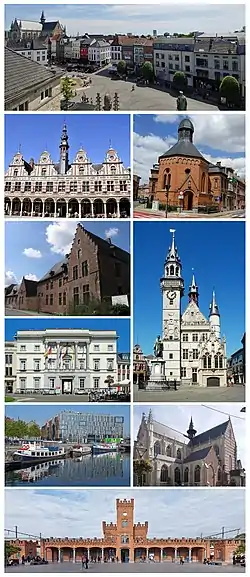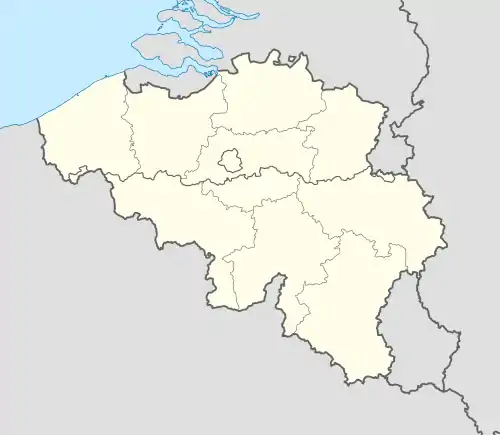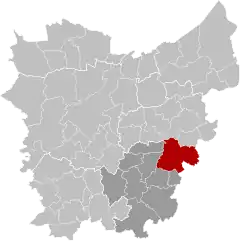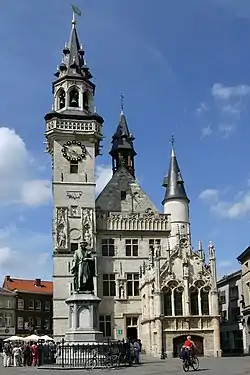Aalst | |
|---|---|
City and municipality | |
 Montage of Aalst | |
_vlag.svg.png.webp) Flag .svg.png.webp) Coat of arms | |
Location of Aalst | |
 Aalst Location in Belgium
Location of Aalst in East Flanders  | |
| Coordinates: 50°56′18″N 04°02′21″E / 50.93833°N 4.03917°E | |
| Country | |
| Community | Flemish Community |
| Region | Flemish Region |
| Province | East Flanders |
| Arrondissement | Aalst |
| Government | |
| • Mayor | Christoph D'Haese (N-VA) |
| • Governing party/ies | N-VA, Open VLD, CD&V |
| Area | |
| • Total | 78.66 km2 (30.37 sq mi) |
| Population (2022-01-01)[1] | |
| • Total | 88,854 |
| • Density | 1,100/km2 (2,900/sq mi) |
| Postal codes | 9300, 9308, 9310, 9320 |
| NIS code | 41002 |
| Area codes | 053 |
| Website | www.aalst.be |
Aalst (Dutch pronunciation: [aːlst] ⓘ; French: Alost, French pronunciation: [alɔst]; Brabantian: Oilsjt) is a city and municipality on the Dender River, 31 kilometres (19 mi) northwest from Brussels in the Flemish province of East Flanders. The municipality comprises the city of Aalst itself and the villages of Baardegem, Erembodegem, Gijzegem, Herdersem, Hofstade, Meldert, Moorsel and Nieuwerkerken; it is the tenth largest city by population with 90.068 inhabitants.[2] Aalst is crossed by the Molenbeek-Ter Erpenbeek in Aalst and Hofstade. The current mayor of Aalst is Christoph D'Haese, from the New-Flemish Alliance party. The town has a long-standing (folkloric) feud with Dendermonde (north along the river), which dates from the Middle Ages.
History


The first historical records on Aalst date from the 9th century, when it was described as the villa Alost, a dependency of the Abbey of Lobbes. During the Middle Ages, a town and port grew at this strategic point, where the road from Bruges to Cologne crossed the Dender. While it was within the Holy Roman Empire it was considered the capital of the province of Flanders.[3] In 1046, Aalst was transferred to the Countship of Imperial Flanders, and absorbed a portion of Brabant, and in 1173 it was united with the remainder of the Flanders province.[3] Its frontier position on the border of the Holy Roman Empire allowed the town to keep a certain degree of independence. Its relation with Brabant has been preserved in the city's white and red coat of arms, the colours of Lotharingia.
Construction of the town hall began in the middle of the 12th century,[4] making it the oldest surviving town hall in Belgium.[5] Several manuscripts from this period still survive in the town archives.[4] During the Hundred Years War the town of Aalst allied themselves with Louis de Male against Philip van Artevelde and sent troops in the victorious Battle of Roosebeke.[6] The town hall, and the city itself, were almost entirely destroyed by fire in 1360. The town was soon rebuilt and a new belfry in gothic style was built in the 15th century. This was a time of great prosperity for the city, dominated by the powerful weavers' guild. It is also at that time that Dirk Martens, a local citizen, became the Southern Netherlands’ first printer, founding a printing shop in 1473[7] that published books by various authors including Christopher Columbus; Martens would later become a professor at the Old University of Leuven,[4] and he was laid to rest in the Saint Martin's Church (Aalst).[8]
Aalst suffered considerably under the Eighty Years' War (1568–1648). It was later taken by the French Marshal Turenne in the War of Devolution of 1667, then occupied by France until 1706, when it became independent once more following the Battle of Ramillies,[3] along with Southern Flanders in general. The textile-based economy flourished under the French. In the 18th century, the Austrians controlled the region.[9] 1830 saw Belgium gain independence and Aalst became part of the country, this ended a long period, starting in 1056, of foreign control, by such as the Spanish, German, French, and the Dutch.[5] The 19th century was marked by social crises engendered by the Industrial Revolution, with Father Adolf Daens and his Christene Volkspartij emerging as the local defender of workers' rights. This was in response to Rerum novarum, which established worker rights. However Daens felt this did not do enough. Eventually, he was made to pay for his "splinter movement".[10] In the Pre-World War II years, the fascist movement in the Low Countries gained momentum, with the collaborationist Vlaamsch Nationaal Verbond (Flemish National Union) putting down roots in the region. Aalst, along with Brussels and Antwerp were the strongest subscribers to this line of thought.[11] The 20th century was marked by bombardment[3] and occupation by the Germans during both world wars.[4]
Economy
.jpg.webp)
The textile industry is still vibrant in Aalst,[12] in part because of the French occupation. Aalst produces not only the textiles themselves, clothing and footwear, but manufactures many of the needed machines. The more rural regions are noted for their production of hops, which are sold to the old breweries there. They also have a large active cut flower business in the region.[9]
Carnival
Aalst is known for its carnival festivities, celebrated every year before Lent. During this celebration, the former town hall belfry is the site of the traditional "throwing of the onions".[12] A Prince Carnival is elected, who is allowed to "rule" the city for three days. A big parade crosses the city on Sunday, with about 70 groups of costumed volunteers and parade cars. Carnival Tuesday or Shrove Tuesday (by tradition, the day before Ash Wednesday), is known as the day of the 'Voil Jeannetten' (literally: "the Dirty Jennies"), i.e., men dressed as women. The festivities traditionally end with the "Burning of the Doll", happening on Tuesday evening. In recent years the carnival has been accused of anti-Semitism due to the repeated use of derogatory imagery against Jews.[13][14]
Controversy
In December 2019, anticipating UNESCO's response to the decision of the carnival organizers to double down on the widely reported use of anti-Semitic stereotypes,[15][16] the mayor of Aalst pre-emptively applied to have his city's carnival removed from the Representative List of the Intangible Cultural Heritage of Humanity.[17] This is the only time such a request has been made.
In 2020 the Aalst parade included more anti-Semitic costumes.[18] These included floats depicting Orthodox Jews with hooked noses standing on sacks of gold coins. Israel's ambassador to Belgium stated “What we are asking for is the prohibition of all these antisemitic cartoons, which are beyond good taste, which have nothing to do with a sense of humor and which do not honor an exemplary democracy such as Belgium.”[19] In response, Belgium’s prime minister, Sophie Wilmès, described the parade as an “internal affair.”[20] UNIA, the Interfederal Centre for Equal Opportunities and Opposition to Racism, stated in a report that no criminal offences were committed, for the parade had no anti-semitic motive, nor the intent to incite hatred or violence against Jews.[21]
In the media
The Belgian TV police drama, 13 Geboden (13 Commandments) was filmed in Aalst.
The Belgian historical drama Thieves of the Wood is set in and around Aalst.[22]
The movie Daens is set in Aalst, it's about Adolf Daens. It's directed by Stijn Coninx.
The movie Niet Schieten also by Stijn Coninx is set and filmed in Aalst.
Sites of interest
- The 15th-century Belfry of Aalst next to the town hall[3] contains a 52-bell carillon, the oldest in Belgium.[4][12] Together with the adjacent Aldermen's House, it was classified by UNESCO as a World Heritage Site in 1999 (part of Belfries of Belgium and France).
- The famous "unfinished" St. Martin's Collegiate Church, in Gothic style, dates back to 1480. It contains a painting by Rubens, Saint Roch beseeching Christ to terminate the Plague at Aalst, and it also has a tabernacle (dated 1605), which features sculptures made by Hiëronymus Duquesnoy the Elder, whose most famous creation is Manneken Pis. This church was damaged in 1914.[3]
- The statue of Dirk Martens (1450–1534),[3] first printer in the Netherlands.[12]
- The old breweries that grow their own hops.[3]
- The Town square has a gallery with a second statue of Martens along with Charles V.[8]
- The city's park.
- The 19th century Neo-Gothic church Saint-Joseph.
- The 19th century Onze-Lieve-Vrouw van Meuleschettekapel.
 Belfry of Aalst
Belfry of Aalst_-_Buitenaanzicht_03.jpg.webp) Saint Martin's Church
Saint Martin's Church.jpg.webp) Terlinden castle
Terlinden castle Saint-Joseph Church (Aalst)
Saint-Joseph Church (Aalst) Onze-Lieve-Vrouw van Meuleschettekapel
Onze-Lieve-Vrouw van Meuleschettekapel
Notable inhabitants
_%E2%80%93_Portrait_of_Pieter_Coecke_van_Aelst.jpg.webp)
- Dirk Martens (c. 1446 – 1534), the first book printer in the Southern Netherlands
- Pieter Coecke van Aelst (1502–1550), painter, sculptor and architect
- Adolf Daens (1839–1907), priest and politician
- Valerius De Saedeleer (1867–1941), painter
- Pieter De Bruyne (1931–1987), designer and interior architect
- Franz Cumont (1868–1947), archeologist, historian, and philologist
- Sébastien Verhulst (1907–1944), Belgian international footballer
- Louis D'Haeseleer (1911–1988), politician
- Louis Paul Boon (1912–1979), writer and journalist
- Herman Le Compte (1929–2008), physician, gerontologist
- Mark De Bie (born 1939), television writer
- Luc Van den Bossche (born 1947), socialist politician
- Wilfried Wesemael (born 1950), cyclist
- Luc Luycx (born 1958), designer of the common side of the euro coins
- Gonda Van Steen (born 1964), classical scholar
- Bert Kruismans, (born 1966), stand-up comedian
- Ilse Uyttersprot (1967–2020), mayor of Aalst
- Patrick Van Goethem (born 1969), countertenor
- Geert De Vlieger (born 1971), football goalkeeper
- Dimitri Verhulst (born 1972), writer and poet
- Peter Van Der Heyden (born 1976), Belgian and international footballer
- Remco Evenepoel (born 2000), professional cyclist
Transport
- Aalst railway station
- Aalst Kerrebroek railway station
- Erembodegem railway station
Symbols
Flag
Description: A rectangle of proportions 2:3, with three vertical bands of red, white and yellow, with a red sword in the middle band pointing upwards. In Dutch: "Drie even lange banen van rood, van wit en van geel, met op het wit een rood zwaard paalsgewijze geplaatst."
Heraldic blazon: Terciated by pale Gules, Argent and Or, a sword of the first pointing upwards.
Coat of arms
Those arms were granted in 1819 and confirmed on 6 February 1841. The oldest known seals of Aalst (13th–14th centuries) show a knight holding a sword in one hand and the Flemish banner in the other, but there is a seal dated 1237 showing the banner with the sword, and even an older seal, dated 1174, with the same features. A later version of the seal (1339–1559) shows a local banner with the sword. A seal from 1407 adds a small shield with the Flemish arms.
The arms of Aalst were first shown in the roll of arms of Gaillard (1557). The sword is probably taken from the old seal with the knight. The two shields show the Imperial eagle and the Flemish lion, recalling the odd status of the Country of Aalst.
Description: The municipal arms of Aalst show on the chief of a white shield two smaller shields separated by a red sword pointing upwards and dividing the whole shield; on dexter, the shield is yellow with a black double-headed eagle with red tongues and claws (Holy Roman Empire); on sinister, the shield is yellow with a black lion with a red tongue and claws (Flanders).
Heraldic blazon: A Modern French shield Argent ensigned by a crown Or and divided in half by a sword palewise pointing upwards Gules between two smaller shields Or; on the dexter shield, a double-headed eagle displayed; on the sinister shield a lion rampant; both Sable armed and langued Gules.
Sport
Aalst has several professional teams:
- The basketball club Okapi Aalstar
- The football club Eendracht Aalst who play in the second division.
- The volleyball club VK Aalst, which was founded in the 1960s, playing in the first division.
- The MotoGP team Repsol Honda are based in Aalst, Belgium.
Twin city
Footnotes
- ↑ "Bevolking per gemeente op 1 januari 2022". Statbel.
- ↑ (PDF) https://www.ibz.rrn.fgov.be/fileadmin/user_upload/fr/pop/statistiques/population-bevolking-20230101.pdf.
{{cite web}}: Missing or empty|title=(help) - 1 2 3 4 5 6 7 8 Blanjean 1997, p. 1
- 1 2 3 4 5 Hoiberg 2010, p. 2
- 1 2 Young & Stetler 1987, p. 55
- ↑ Cook 2004, p. 15
- ↑ Canby 1984, p. 1
- 1 2 Ogrizek 1961, pp. 124–125
- 1 2 Cohen 1998, p. 1
- ↑ Cook 2004, p. 89
- ↑ Clough 1946, p. 124
- 1 2 3 4 Munro 1995, p. 1
- ↑ "Israeli minister says Belgium should ban Aalst Carnival for 'vitriolic' antisemitism". The Brussels Times. 20 February 2020.
- ↑ Robin Emmott (23 February 2020). "Belgian carnival defies calls to cancel parade with Jewish caricatures". Reuters.
- ↑ "Aalst Carnival makes fun of Jews again, despite anti-Semitism accusations over previous edition". The Brussels Times. 21 October 2019.
- ↑ Cnaan Liphshiz (23 October 2019). "Belgian parade mired in anti-Semitism prints Jewish caricatures for participants". Times of Israel.
- ↑ "Aalst removes Carnival from UNESCO World Heritage list". The Brussels Times. 2 December 2019.
- ↑ "Belgian city of Aalst says anti-Semitic parade 'just fun'". BBC News. 24 February 2020.
- ↑ Belgian carnival to go ahead despite row over 'hateful' antisemitism, The Guardian, Daniel Boffey in Brussels, Fri 21 Feb 2020 12.49 GMT
- ↑ Belgian carnival to go ahead despite row over 'hateful' antisemitism, The Guardian, Daniel Boffey in Brussels, Fri 21 Feb 2020 12.49 GMT
- ↑ "Carnival and the limits of freedom of expression".
- ↑ "Thieves of the Wood Season 1 Review: The Flemish Bandits". Ready Steady Cut. 2 January 2020. Retrieved 24 October 2020.
- ↑ Anon 2014a
References
- Anon (2014). "From Then til Now". www.brabantia.com. Archived from the original on August 19, 2014. Retrieved August 2, 2014.
- Anon (2014a). "Twin Towns". Gabrovo Municipality. Archived from the original on April 27, 2014. Retrieved August 2, 2014.
- Blanjean, Lucienne (1997). "Aalst". In Johnston, Bernard (ed.). Collier's Encyclopedia. Vol. I: A to Ameland (1st ed.). New York, NY: P. F. Collier.
- Canby, Courtlandt (1984). "Aalst". In Carruth, Gorton (ed.). The Encyclopedia of Historic Places. Vol. I: A-L. New York, NY: Fact on File Publications. ISBN 0-87196-126-1.
- Clough, Shepard B. (1946) [1945]. "IX: The Flemish Movement". In Goris, Jan-Albert (ed.). Belgium. The United Nations. Berkeley, CA: University of California Press. ASIN B001VSF64A.
- Cohen, Saul B., ed. (1998). "Aalst". The Columbia Gazetteer of the World. New York, NY: Columbia University Press. ISBN 0-231-11040-5.
- Cook, Bernard A. (2004). Belgium: A History. Studies in Modern European History. Vol. 50. New York, NY: Peter Lang Publishing, Inc. ISBN 0-8204-5824-4.
- Hoiberg, Dale H., ed. (2010). "Aalst". Encyclopædia Britannica. Vol. I: A-Ak - Bayes (15th ed.). Chicago, Illinois: Encyclopædia Britannica, Inc. ISBN 978-1-59339-837-8.
- Munro, David, ed. (1995). "Aalst (Alost)". The Oxford Dictionary of the World. Oxford, UK: Oxford University Press. ISBN 0-19-866184-3.
- Ogrizek, DoreÌ (1961) [1950]. Belgium and Luxembourg. The World in Color. ASIN B0007H5COK.
- Young, Margaret Walsh; Stetler, Susan L., eds. (1987). "Belgium". Aalst. Cities of the World. Vol. 3: Europe and the Mediterranean Middle East (3rd ed.). Detroit, MI: Gale Research Company. ISBN 0-8103-2541-1.
External links
 Media related to Aalst, Belgium at Wikimedia Commons
Media related to Aalst, Belgium at Wikimedia Commons Aalst, Belgium travel guide from Wikivoyage
Aalst, Belgium travel guide from Wikivoyage- Official website Archived 2007-12-21 at the Wayback Machine - Only available in Dutch
